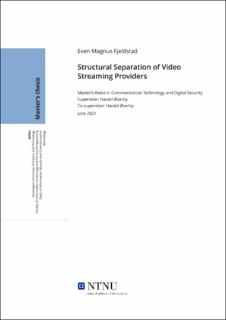| dc.contributor.advisor | Øverby, Harald | |
| dc.contributor.author | Fjeldstad, Even Magnus | |
| dc.date.accessioned | 2021-09-30T16:24:09Z | |
| dc.date.available | 2021-09-30T16:24:09Z | |
| dc.date.issued | 2021 | |
| dc.identifier | no.ntnu:inspera:80310926:20551856 | |
| dc.identifier.uri | https://hdl.handle.net/11250/2786747 | |
| dc.description.abstract | Filmer og tv-seier er nå mer mangfoldig og tilgjengelig enn noensinne takket være framveksten av video-strømmetjenester. Markedet består av flere leverandører som hovedsakelig konkurrerer med eksklusivt innhold for å oppnå konkurransefortrinn i markedet. Konkurranse med eksklusivt innhold er mulig gjennom vertikal integrasjon, som betyr at leverandørene av strømmetjenestene også fungerer som innholdsleverandører. Denne måten å konkurrere på er upraktisk for forbrukere, skaper høyere inngangsbarrierer til markedet, og hindrer innovasjon og forbedringer. Disse problemene kan løses ved hjelp av strukturelle separasjoner, som er et antitrust-middel hvor man splitter opp selskaper og setter begrensninger på hvilke områder de kan operere i. Denne oppgaven presenterer hvordan video-strømmetjeneste industrien fungerer, og hva strukturelle separasjoner er.
Ved å bruke metoden design science, har jeg designet en strukturell separasjon som er spesifikt designet for å eliminere konkurranse med eksklusivt innhold i video-strømmetjeneste industrien. Min strukturelle separasjon forbyr selskaper fra å eie både video-strømmetjenester og innholdet de tilbyr. I tillegg, vil min strukturelle separasjon forby innholdsleverandører fra å lisensiere innholdet sitt til video-strømmetjenester eksklusivt. Siden min strukturelle separasjon vil gjøre alt mulig innhold tilgjengelig for alle mulige leverandører av video-strømmetjenester, så vil forbrukere potensielt kun trenge å abonnere på én tjeneste for å få tilgang til alt innholdet de ønsker. Uten eksklusivt innhold blir leverandørene av video-strømmetjenester nødt til å finne andre måter å konkurrere på, mest sannsynlig blir dette innen funksjoner, teknologi, og design. Nye aktører i markedet vil ikke trenge å investere milliarder for å få tak i eksklusivt innhold, noe som fører til lavere inngangsbarrierer i markedet.
De største bidragene til denne oppgaven er at den viser at det er store problemer i video-strømmetjeneste industrien og at den foreslår en strukturell separasjon som er spesifikt designet for å håndtere disse problemene. Den forslåtte løsningen kan bli brukt som et fundament for hvordan video-strømmetjeneste industrien kan reguleres. | |
| dc.description.abstract | Movies and television series are now more numerous and available than ever before largely thanks to the emergence of video streaming services. The video steaming market features some intense competition with exclusive content as the primary way of gaining competitive advantages. Competition with exclusive content is enabled by vertical integration, meaning that video streaming providers are also content providers. This way of competing creates inconveniences for consumers, higher barriers to entry in the market, and stifles innovation and improvements. These problems can be solved with structural separation, which is an antitrust remedy which involves breaking up companies and imposing clear limits in which areas they are allowed to engage in. This thesis presents how the video streaming industry functions and what structural separations are.
By using design science methodology, I have designed a structural separation specifically suited to eliminate competition with exclusive content in the video streaming industry. My structural separation prohibits companies from owning both a video streaming service and video content. In addition, my structural separation prohibits video content providers form licensing their content to video streaming providers exclusively. As my structural separation would make all kinds of video content available to all kinds of video streaming providers, consumers would potentially only need to subscribe to one kind of video streaming service in order to watch all the content they want. No exclusive content would mean that existing video streaming providers would need to find other ways to compete, likely through features, technology, and design. New entrants to the market will not have to invest billions into acquiring exclusive content in order to compete on equal footing with existing participants, lowering the barriers to entry in the market.
The major contributions of this thesis is that it shows that there are major flaws in the video streaming industry and that it proposes a structural separation specifically designed to deal with those flaws. The proposed solution may be used as a foundation for actual implementation of regulations on the video streaming industry. | |
| dc.language | eng | |
| dc.publisher | NTNU | |
| dc.title | Structural Separation of Video Streaming Providers | |
| dc.type | Master thesis | |
